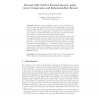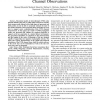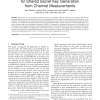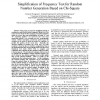ESORICS
2012
Springer
12 years 9 months ago
2012
Springer
We show that it is possible to achieve perfect forward secrecy in two-message key exchange (KE) protocols that satisfy even stronger security properties than provided by the extend...
EUROCRYPT
2012
Springer
12 years 9 months ago
2012
Springer
This paper proposes the first inner product encryption (IPE) scheme that is adaptively secure and fully attribute-hiding (attribute-hiding in the sense of the definition by Katz...
ICC
2009
IEEE
14 years 4 months ago
2009
IEEE
Theoretical models of ultrawideband (UWB) radio channels indicate that pairs of UWB radio transceivers measure their common radio channel with a high degree of agreement and third ...
TMC
2010
14 years 5 months ago
2010
—Secret keys can be generated and shared between two wireless nodes by measuring and encoding radio channel characteristics without ever revealing the secret key to an eavesdropp...
SCN
2010
Springer
14 years 5 months ago
2010
Springer
Exposure of a secret key is a significant threat in practice. As a notion of security against key exposure, Dodis et al. advocated key-insulated security, and proposed concrete k...
CORR
2010
Springer
14 years 5 months ago
2010
Springer
Abstract— We investigate secret key generation for a “pairwise independent network” model in which every pair of terminals observes correlated sources which are independent o...
IJNSEC
2008
14 years 6 months ago
2008
To enhance the efficiency of threshold group signature schemes, Yu and Chen, recently, proposed an efficient threshold group signature scheme. By using elliptic curves, the propos...
AICT
2008
IEEE
14 years 6 months ago
2008
IEEE
This paper presents the simplified method of random test suite based on the frequency (block) test. The test is used to check the first property of random numbers which is to have ...
ICISC
2008
14 years 8 months ago
2008
Ciphertext-Policy Attribute-Based Encryption (CP-ABE) allows to encrypt data under an access policy, specified as a logical combination of attributes. Such ciphertexts can be decry...
ESORICS
2008
Springer
14 years 8 months ago
2008
Springer
Key agreement is a fundamental security functionality by which pairs of nodes agree on shared keys to be used for protecting their pairwise communications. In this work we study k...




